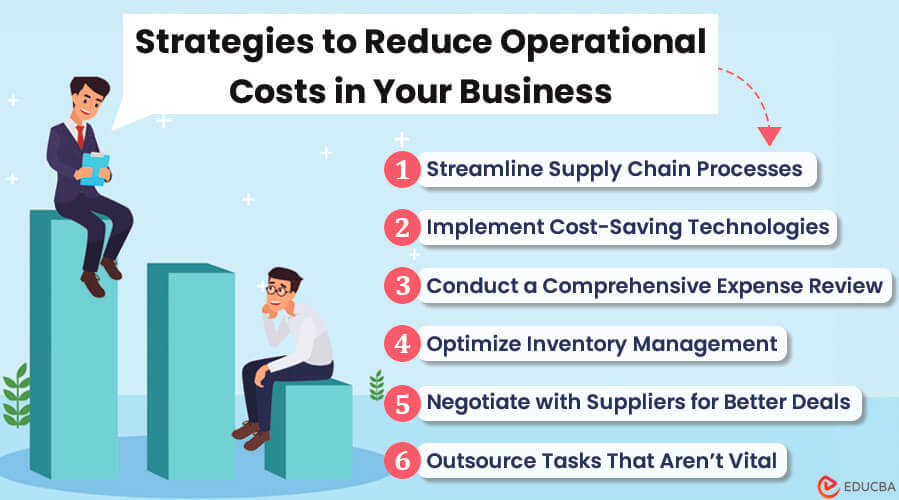
Why Reduce Operational Costs in Business?
While operational costs (like maintenance and administrative costs) are fundamental to any business, streamlining these costs can improve your company’s profitability. Moreover, reducing operational costs can also improve efficiency financial performance and maintain competitiveness.
In this blog, we will explore various proven techniques for managing and reducing operational expenditures. Let’s get started!
Table of Contents
- Key Strategies
Key Strategies to Reduce Operational Costs
The following are some key strategies for reducing operational costs in your business.
1. Streamline Supply Chain Processes
Optimizing the supply chain involves streamlining processes, which is the best way to reduce operation costs. Follow the steps below to optimize the supply chain.
- Consider combining multiple orders into one shipment and negotiating better deals with suppliers.
- Perform a thorough review of your present supply chain procedures and identify inefficiencies and improvement areas. This assessment involves understanding the dynamics between different suppliers and how their performance impacts your costs.
- Build closer relations with dependable suppliers to obtain better prices and deals.
All these will reduce shipping and storage costs, help manage inventory better, and make operations more efficient, thereby reducing operational expenses.
2. Implement Cost-Saving Technologies
Integrating technology into your processes can result in substantial savings on expenses. You should focus on technologies that automate and streamline business processes.
Automated stock inventory management systems can decrease labor costs associated with stock management and reduce human errors. For example, you can integrate tools like spend control software from Payhawk, which helps track all your business expenses.
To save electricity costs, you can also consider energy-saving solutions, such as intelligent thermostats and LED lighting. Teaching employees how to utilize these technologies to maximize their advantages is also crucial.
3. Conduct a Comprehensive Expense Review
You must regularly review your expenses to identify areas where you can trim costs. This process involves:
1. Gather financial documents such as bank statements, bills, and receipts to assess expense data.
2. Then, organize and categorize your expenses into categories like utilities, rent, and payroll to better understand where your money goes.
3. Identify unnecessary expenses and operational areas where you can cut costs without affecting your business’s efficiency.
If you do detailed reviews regularly, it can reveal surprising opportunities for cost savings.
4. Optimize Inventory Management
A key factor to reduce operational costs is effectively managing inventory. You should keep appropriate stock levels – enough to fulfill market demand. Also, overloading of stocks will result in expensive storage costs or depreciation.
Optimizing inventory involves:
- Analyzing sales data and market trends will help forecast or predict accurate demand.
- Regularly analyzing your inventory turnover rates will assist in detecting slow-moving or obsolete products.
- Adopting a just-in-time inventory approach can also be beneficial, as it means aligning your inventory with production and demand when necessary, lowering storing costs, and preventing overstocking in inventory.
5. Negotiate with Suppliers for Better Deals
You can negotiate with suppliers for reasonable prices to lower operating expenses. This approach will also create value in the relationship.
For this,
- Start by researching market pricing trends to understand what you can reasonably request.
- Discuss your requirements and how they fit with your supplier’s abilities.
- Negotiate deals with mutual benefits, such as bulk discounts, extended payment periods, or packaged services.
Maintaining sound relationships with suppliers is crucial, as they are more likely to negotiate favorably with trusted partners. Additionally, consider periodically exploring alternative suppliers to keep your options open and ensure you get the best value.
6. Outsource Tasks That Aren’t Vital
Outsourcing in organizations means assigning non-core operations to external firms, which helps organizations focus on their core capabilities.
You can identify areas essential to your business but not a part of your core service or product offering, such as IT support, HR, customer service, or accounting. Outsourcing these functions to specialized firms can result in cost savings, access to expert knowledge, and improved efficiency.
Choosing outsourcing partners who align with your business values and have a proven track record of quality service is crucial. This approach reduces your operational burden and allows you to use the expertise and technology of these external providers.
Final Thoughts
To conclude, reducing operational costs is a multi-step procedure that requires a strategic approach. The strategies discussed in the article can enhance your business’s monetary performance. This will create more efficient, cost-effective operations that support long-term sustainability and growth. Remember, the goal is not just to trim expenses but to maintain or enhance the quality and value of your business offerings.
Frequently Asked Questions (FAQs)
Q1. What role do employees play in reducing operational costs?
Answer: Employees are crucial in identifying inefficiencies and suggesting improvements. Encouraging a culture of cost-consciousness and efficiency among staff can lead to significant savings.
Q2. Is there a risk of cutting operational costs too much?
Answer: Yes, excessive cost-cutting can damage the standard of goods or services, morale of workers, and consumer satisfaction. It is important to balance cost reduction while maintaining the value and standard of business operations. You must strategically plan cost reduction methods to enhance efficiency without negatively impacting core business functions.
Recommended Articles
We hope this “Key Strategies to Reduce Operational Costs in Your Business” article was informative. You can also refer to the articles below for more information.

